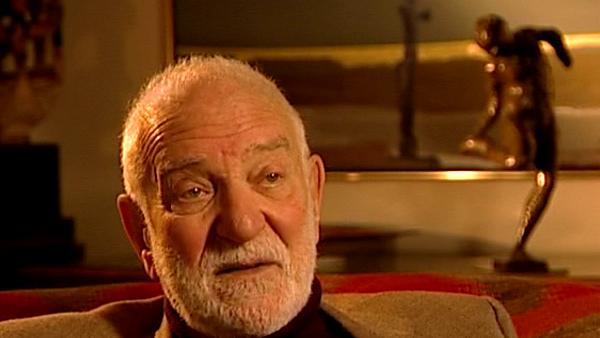The Triangle had been going for a few years – about three or four years – and Peter Palumbo came in as our Chairman, and he said, ‘I like the idea of Triangle’, and he had come up and seen it. And he said, ‘But I think you should have architects’; you know, he loves architecture. And I said, ‘I think that's a good idea but how would we... how would we get them in?’, and what were they going to do, and so on? ‘Let's ask a few', he said. So we had lunch with Richard – Richard Rogers – and had lunch with Norman Foster, but they were all too busy, and he said, ‘There's this architect –’ I hadn't heard of him – Frank Gehry. ‘Well, let's meet him'. And I met him in New York, and we talked a bit about an idea I had for making a sculpture into a... a piece of architecture, and he said, ‘You do that’, but he said, ‘Let's work freely when... when I do this thing; I will come and do it with you’. And so we had him as one architect, and then there were the... this other architect, who was a local architect from Pine Plains, who built a kind of pavilion, which he put sculptures into, and we also had Peter and Alison Smithson who I knew because they did this building. And they said, ‘Well, we're sort of enablers and we will try and convert a building so that it can be used with... in conjunction with paintings and sculpture’.
I thought that the idea of working with Frank Gehry was the most inventive because it was really starting from scratch, working together. And we had a little group: Frank and his two assistants, Sheila, Jon Isherwood and me, and we worked as a team, going our sort of separate ways. We took... we enlarged pieces of parts of my sculpture; we enlarged them to about ten feet high in wood, and then we had the local builder with his forklift truck move those about, and... so they made sort of different configurations and then Frank would come in, and say, ‘Well, we need a roof on that’, and so on and so forth. And we began to get something going very good, but it was more like a village than it was an architecture. And then Frank got a job and was called away so that we... he left with his... he left his two assistants but they weren't... they were drawing it out; they weren't really seeing it in his way. So in a way he only did about half the...half the project. But we got along well and I learnt a lot from it. I think Frank is a sort of sculptor manqué, more than an architect in a way. You know, he's... he's brought... he's brought sculpture to architecture; he's brought architecture towards sculpture. Quite different from somebody like Ando and so on, who thinks, I think, very much like an architect, like... Oh, we had a discussion actually a couple of years... two or three years later, we had a discussion, a public discussion in Japan as to what was the difference between architecture and sculpture and I didn't think...
[Q] You and Tadao Ando?
And... and Frank Gehry and Pierre Soulage and Isozaki, and I mean it was a public thing; it was at the time I had to be in Japan to get a prize, and they put this thing on and it was... it was very interesting. I think actually what Ando said, which was that he saw architecture as really a silent place for the inhabitants and he worked outwards from that. But I don't think Frank ever did; I think Frank worked inwards from a... a sculptural concept. We got along... we got along well. We didn't make anything that I thought was good enough, anywhere near, and it was destroyed afterwards anyway. But there were ideas in there which got me going, which was very good, and got me thinking about the idea of almost enclosure, almost walking in, almost having a roof on it, you know, which I found was nice for me, really... really terrific. So I made this sculpture which was called "Cathedral", and I remember saying to Karen Wilkin, ‘Come and see my sculpitecture’, and it was a joke. The words got... caught on as sculpitecture; it wasn't sculpitecture. I mean it was... it was a sculpture but it was... it was very close to architecture and bit by bit, over the years, I've kind of developed that quite a lot.






